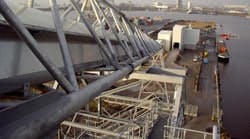A 20-MW biomass-powered generating station needed a totally enclosed, air-supported conveyor system to feed its new woodchip-fired block and achieve control of fugitive materials in the strong winds common to its North Sea location. Owned by E.ON Kraftwerke and Statkraft Markets and managed by Statkraft Markets Kraftwerksgruppe Nord-West, the facility’s new conveyor has been able to comply with dust control specifications and prevent nuisance dust from accumulating on nearby automobiles.
At the outset, company officials knew they needed a conveyor with a relatively long span to transport bulk material 548 ft from the ship-unloading facility to two storage silos. In addition, because of the proximity to the sea, corrosion protection was essential to the conveyor system’s durability. Complicating the engineering task was a limited amount of space for the conveyor’s support structure. The system would be expected to operate for extended periods with little maintenance, prevent the escape or buildup of fugitive material and protect the load from rain that would introduce unwanted moisture to the fuel.
Specify the right system
After reviewing the options, the company specified Martin Engineering’s conveyor design. The air-supported conveyor is designed to resolve many of the problems encountered with conventional belt conveyors.
By eliminating idlers and pinch points, the fully enclosed, air-supported system prevents airborne particles and reduces maintenance requirements and potential safety risks.
“Air-supported conveyors eliminate the carrying-side idlers used on conventional designs,” explains Werner Baxmann, European sales and marketing manager for Martin Engineering. “Instead, they employ a film of air rising from a troughed pan to lift the belt. By removing a source of friction and the need for periodic maintenance, air-supported designs can offer significant advantages, including energy, environmental and safety benefits,” he says. This thin air film is designed to support loads properly and deliver high speed operation, while generating virtually no mechanical friction. To accommodate space limitations at the Emden facility, the conveyor structure was engineered with a triangular framework. Constructed of galvanized steel to withstand the coastal climate, the high-strength modular design spanned the entire distance with two intermediate supports. The conveyor is 40 in. wide and travels up a constant 10° incline for a total elevation of 97 ft over its total span.
Designed for a smooth ride
The concept of the air-supported design is fairly simple, with the load zone and carrying sections contained in a plenum, which is pressurized by a centrifugal fan. Holes in the top of the plenum produce an air film between the plenum and belt, which supports the moving load. Starting with the weight of the belt and the load, system designers estimated the pressure needed to deliver about 1 mm of lift, which requires minimal air volume in most applications.
The conveyor needs no compressor and is able to power up to 600 ft of belt supported by a single low-power fan.
Pursuit of perfection
“Even in the best of installations, the troughing idlers in conventional systems can’t provide a perfect belt line,” explains Baxmann. “The up-and-down motion agitates the material, which can cause some particles to become airborne. That disturbance also can push material to the outside edges of the belt, where it might be spilled. The stable belt path of the air-supported system minimizes turbulence and the resulting fugitive material.”
[pullquote]The air-supported design also can eliminate maintenance concerns such as idler replacement and belt alignment, and the modular system allows replacement of existing conveyor sections with CEMA standard construction. Air-supported and conventional roller sections can be integrated to accommodate loading zones, tracking idlers, belt scales or other needs.
On new conveyors, the air-supported systems are engineered to suit specific requirements. By eliminating idlers and pinch points, the air-supported system further reduces maintenance requirements and potential safety risks.
The Emden plant reports low amounts of maintenance service for the air-supported design. The conveyor has exceeded the company’s 98% operational requirement, and the fully enclosed system prevents the escape of dust. The facility converts about 130,000 metric tons of biomass into energy each year, with the conveyor transporting 110-120 metric tons per hour.
